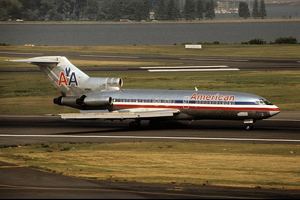Passengers 81 Fatalities 37 Survivors 51 Number of deaths 37 Location Saint Thomas | Crew 7 Injuries (non-fatal) 39 (1 on the ground) Date 27 April 1976 Summary Pilot error Survivor 51 | |
 | ||
Site St. Thomas, U.S. Virgin Islands Similar Aeroflot Flight 418, American Airlines Flight 514, Indian Airlines Flight 171, EgyptAir Flight 864, American Airlines Flight 28 | ||
American Airlines Flight 625, a Boeing 727-100, crashed at St. Thomas, U.S. Virgin Islands on April 27, 1976, while on a domestic scheduled passenger flight originating at T. F. Green Airport in Rhode Island and ending at Saint Thomas, United States Virgin Islands with an intermediate stop at John F. Kennedy International Airport.
The American Airlines Boeing 727-23, registration N1963, overran the departure end of Runway 9 when landing at the Harry S Truman airport. The aircraft struck an Instrument Landing System antenna, crashed through a chain link fence, and traveled another 1,040 feet (320 m) until stopped by a gas station. The aircraft was destroyed.
The airport at St. Thomas was notorious among pilots for its short (4,658 ft) runway. In fact, the Boeing 727 was the heaviest aircraft type authorized to use it, and even then it was only authorized in one direction.
Ultimately, the NTSB attributed this crash to pilot error on the approach – for example the maximum flap setting of 40 degrees was never applied, which meant that the aircraft's speed was 10 knots (19 km/h) higher than VREF as it crossed the runway threshold. This, combined with the fact that the aircraft 'floated' from the turbulent winds in the area, meant that it was already 2,300 feet (700 m) down the runway at the point of touchdown. The pilots did not act quickly enough on the brakes and proceeded to go full-throttle three seconds after touchdown. However, they were unable to reach take-off speed because the 727's engines are slow-responding, taking about 6.6 seconds to power up. After five seconds of waiting for power, and with only 700 feet (210 m) of runway left, the pilot panicked, according to the report, and applied full brakes. Further, the pilot forgot to apply reverse engine thrust until immediately before impact. Ultimately, the aircraft ran off the end of the runway and into a Shell gas station, killing 37 (35 passengers and two flight attendants) of the 88 on board. 38 other passengers and crew were injured and one person on the ground was seriously injured. The probable cause was the captain's actions and his judgment in not being aware that when he touched down 2,300 feet (700 m) into the 4,658-foot (1,420 m) runway, he did not have enough distance to perform a go-around.
As a result of the crash, American Airlines ended all jet flights to St. Thomas, flying instead to St. Croix (which had a longer 7,600 foot runway at the time). American Airlines passengers were then flown to St. Thomas in Convair 440 propeller-driven aircraft from St. Thomas as well as from San Juan with these flights being operated by a wholly owned subsidiary, American Inter-Island Airlines. Jet flights operated by American resumed when the runway at St. Thomas was lengthened to 7,000 feet (2,100 m).
In popular culture
American Airlines Flight 625 was specifically mentioned in the movie Rain Man.
